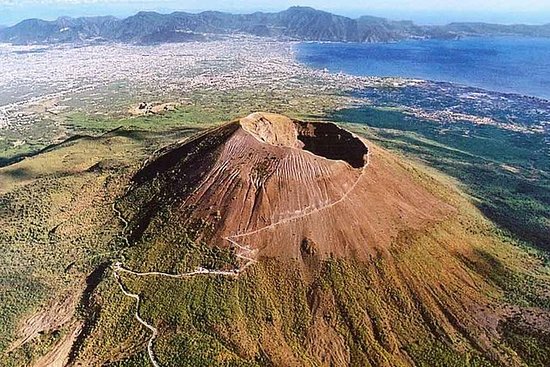How do volcanoes form?
Volcanoes form when an oceanic plate subducts underneath a continental plate. This occurs because of the denser oceanic plate being forced underneath the continental plate. While this is occurring, the oceanic plate melts as it is pushed down further towards the mantle, becoming less dense. This liquid rock -- called magma -- rises to the surface and causes a pressure build-up inside of the Earths crust. It eventually breaks through the cracks in the continental plate, causing a volcano. Now coming out as lava, the liquid rock creates a new crust, and after several volcanic eruptions, it forms the well-known volcano shape. Volcanoes are most commonly found in the ring of fire, an area of the Earth where the Pacific plate resides. This oceanic plate is one of the largest and due to being an oceanic plate will subduct around all the surrounding continental plates. This causes the many volcanoes that surround the Pacific plates edges.
Mount Vesuvius
 Located on Italy's west coast, Mount Vesuvius was only 8 kilometres away from Pompeii. The city this volcano famously destroyed in 79 AD. Mount Vesuvius' last eruption occurred only 75 years ago in the March of 1944, beginning on the 17th, it was said to have lasted a fortnight. The eruption killed a reported 26 Italian citizens and another three were killed in Terzigno by volcanic rocks falling from the volcanoes explosion. This is a lucky escape for most as the volcanoes destruction was large, the lava bombs that came from the sky were said to be the size of a basketball. This is especially impressive when we look into the 1998 incident, where 150 people were killed by a large amount of ash rain, debris flows and ash deposits.
Located on Italy's west coast, Mount Vesuvius was only 8 kilometres away from Pompeii. The city this volcano famously destroyed in 79 AD. Mount Vesuvius' last eruption occurred only 75 years ago in the March of 1944, beginning on the 17th, it was said to have lasted a fortnight. The eruption killed a reported 26 Italian citizens and another three were killed in Terzigno by volcanic rocks falling from the volcanoes explosion. This is a lucky escape for most as the volcanoes destruction was large, the lava bombs that came from the sky were said to be the size of a basketball. This is especially impressive when we look into the 1998 incident, where 150 people were killed by a large amount of ash rain, debris flows and ash deposits. Are there and stories or myths surrounding it?
The mythological significance surrounding Mount Vesuvius spawns from the Ancient Romans beliefs in their gods. The stories have to do with the stories of Jupiter, the god of sky and lightning, and his son, Hercules. So much so, they considered the mountain devoted to the demigod Hercules. This is because while completing his labours, he crossed a 'plain of fire,' or 'from a hill which anciently vomited out fire ... now called Vesuvius.' The destructions of Pompeii notably was thought to be Jupiter's doing, and that he was attempting to remind humanity of who is in charge.

First, we mixed the potassium iodide and the water together in a small beaker until it was clear. While I was doing this my team members created the mixture of all the other ingredients and tipped them into the bottle inside of the volcano. To create the final explosion we added the iodide mixture into the bottle and watched the magic.
Volcano Model
After researching volcanoes we were given the task to create a model of one of the volcanoes that one of the members in our group had chosen. My group's volcano was modelled after my volcano, Mount Vesuvius. Using paper mache, we created the structure of the volcano and later painted it. As any class would've done with many volcano models, we made them erupt, however, it was not the typical baking soda and vinegar mixture. Instead, we used 20mls of 35% hydrogen peroxide, 4 small scoops of potassium iodide, 20mls of water and a squirt of dishwashing liquid to create Elephants Toothpaste. Food colouring and glitter was also added for colour and effect.
First, we mixed the potassium iodide and the water together in a small beaker until it was clear. While I was doing this my team members created the mixture of all the other ingredients and tipped them into the bottle inside of the volcano. To create the final explosion we added the iodide mixture into the bottle and watched the magic.
This experiment worked because Hydrogen peroxide is water and oxygen and slowly separates into these two things, the potassium iodide was added to the hydrogen peroxide to speed up the process of the separation. This created the illusion of an eruption. The glitter we had added into the mixture gave a stunning effect afterwards that the lava was made of pure glittering gold.
No comments:
Post a Comment
Note: only a member of this blog may post a comment.